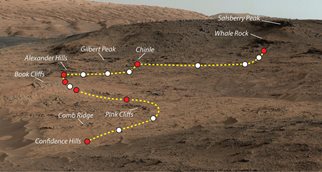Playing is Learning
Major discoveries of the Curiosity Rover to Mount Sharp
October 11th, 2016
| Ads | ||
|
Play the Challenge
|
||
|
A New Word is Coined A new Character is revealed A new Game is Afoot |
An Edutainment Adventure Based on Three Rounds of Investigations
|
|
|
Welcome to the World of PROFESsee™by seeCOSM™ PROFESsee™ is my title. I am the perpetual learner, in pursuit of knowledge, wisdom and truth. I derived my name from professor |
 |
|
|
Well into its third Martian year (687 Earth days), the Curiosity Rover can see the finish line (but mind you, here there’s no sprint finish) – Mount Sharp – after reaching the base of the mountain early September of 2014, to undertake the last lap of its mission – assuming other discoveries wouldn’t require extra probing. Since its arrival and later climb up the mountain, Curiosity has discovered a number of things that have surprised, confirmed older assumptions, and discovered things entirely different from the surrounding Gale Crater. One of the major discoveries thus far is the uncovering of a mineral - tridymite that had never been seen on Mars and scarce on earth. The mineral was discovered when the rover made a drill into the red surface layers of the Red Planet, puffing up blue dust in the process. The tridymite is possible pointers to a suspected volcanic past. On Earth, tridymite has high silica content and is found in volcanic deposits. As a NASA spokesperson said, “Tridymite found at Buckskin may be evidence for magmatic evolution on Mars.” On October 5, 2015, possible seasonal flows on warm Martian slopes also called recurring slope linae (RSL) were reported on Mount Sharp by the rover. RSL are assumed salty water flow caused by the warmest months on Martian terrain. Apart from the discovery by the Curiosity Rover, other space probing spacecraft have also made the discovery, and in fact, there are ongoing RSL studies. Its importance lies in the past research that indicates “liquid water was flowing” on Mar’s surface, much like the oceans on Earth. Their presence and research can help explain what happened to all the water. Did an alien form come to “gazump” all the water? Fingers crossed (or toes if you can). Curiosity Rover has also found out that Mount Sharp – bam at the center of Gale Crater – was indeed built by deposited sediments from a lake bed tens of millions of years ago. Experts are led to believe that the Gale Crater was certainly at a point in time an ocean. The analysis carried out by the Rover at the base of the mountain revealed patterns indicating that there was flowing water coming through at different levels many million years ago. Can you Identify the discoveries? Image courtesy of: http://marsmobile.jpl.nasa.gov/multimedia/images/?ImageID=6722 |
||
Latest News / Events
E-mail [email protected]
The Professee™ Newsletter Beta
http://www.seecosm.com/
http://www.seecosm.com/

